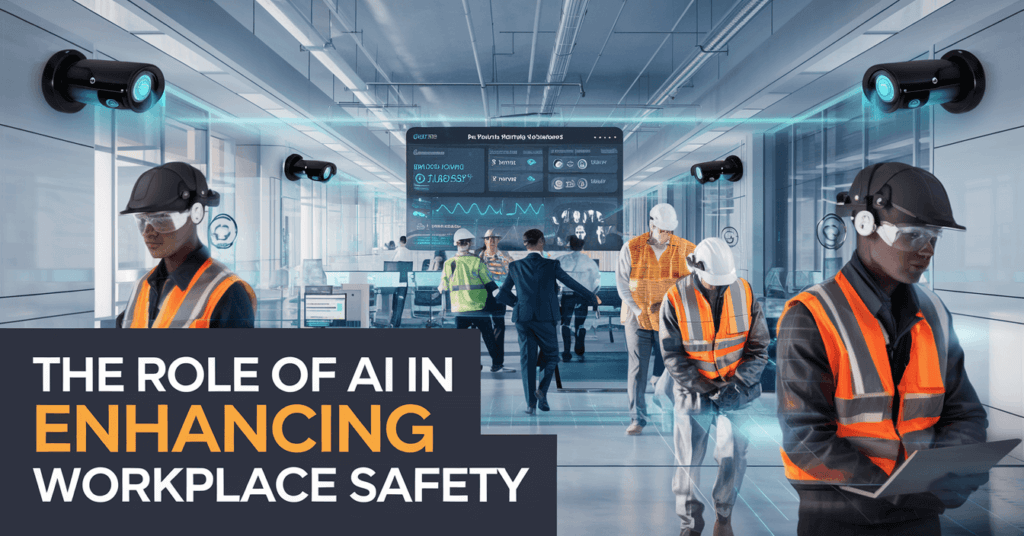
The Role of AI in Enhancing Workplace Safety
Posted on February 10, 2025 | By admin
5 Min Read
The Role of AI in Enhancing Workplace Safety
In today’s rapidly evolving technological landscape, Artificial Intelligence (AI) is playing a pivotal role in improving workplace safety across various sectors. With industries increasingly turning to automation, AI-powered tools are transforming how workplaces manage risks, enforce safety protocols, and protect employees from hazards. In this blog, well explore how AI and safety intersect, highlighting the latest trends, technologies, and innovations in the field.
AI and Workplace Safety : A Game-Changer
Workplace safety has long been a critical concern for organizations. With the advent of AI, there are now smarter ways to enhance safety procedures. AI tools have the potential to monitor, analyze, and even predict safety risks in real-time, which makes them indispensable in industries like construction, manufacturing, logistics, and healthcare.
Key AI Technologies Revolutionizing Workplace Safety
AI-Powered Surveillance and Monitoring
AI-based surveillance systems have revolutionized workplace safety by using advanced computer vision and machine learning algorithms to detect potential hazards. These systems continuously monitor the work environment, identifying unsafe conditions, unauthorized access, and compliance with safety gear (such as helmets or masks) through real-time video analysis.
Predictive Maintenance and Accident Prevention
Predictive analytics, driven by AI, can foresee equipment failures before they occur. This minimizes downtime and helps prevent accidents caused by malfunctioning machinery. IoT (Internet of Things) sensors and AI-powered platforms collect and analyze data from machines, offering insights that enable proactive maintenance, thus reducing safety risks and costly breakdowns.
AI-Enhanced PPE Compliance
Personal Protective Equipment (PPE) compliance is vital for industries like construction and mining. AI solutions use facial recognition and image analysis to ensure workers are wearing the correct safety gear, alerting supervisors when compliance issues arise. This reduces human error and improves adherence to safety protocols.
AI for Environmental Hazard Detection
AI-powered sensors can detect environmental hazards like gas leaks, fires, or chemical spills before they become life-threatening. These systems monitor air quality, temperature, and pressure levels in real-time, and can trigger alarms, shut down systems, or send evacuation alerts to ensure worker safety.
Behavioral Analytics and Safety Culture
AI is being leveraged to analyze employee behavior, identifying patterns that indicate potential safety risks. For example, AI algorithms can track fatigue, stress levels, and ergonomic postures, predicting when workers are likely to make errors or experience injuries. With this data, organizations can implement preventative measures to reduce workplace accidents.
AI and Safety in the Era of Industry 4.0
As industries embrace Industry 4.0—the integration of AI, IoT, and big data—workplace safety is experiencing a paradigm shift. AI-driven automation and digital twins allow for virtual simulations of real-world environments, enabling safety teams to model different scenarios and optimize safety measures without exposing workers to danger.
The use of robotic process automation (RPA) and collaborative robots (cobots) in hazardous work environments also reduces the need for human intervention, decreasing the likelihood of injury. AI ensures that these machines operate efficiently and safely alongside human workers, creating a more secure, productive workspace.
The Future of AI in Safety : Emerging Trends
AI-Driven Wearables
AI-enhanced wearable technology is becoming more prevalent, especially in high-risk industries. These devices, embedded with AI, monitor worker health (such as heart rate or body temperature) and environmental conditions. Wearables equipped with machine learning algorithms can detect abnormal data trends and immediately alert workers and supervisors, preventing injuries before they occur.
Autonomous Safety Inspections
Drones and AI-enabled robots are now being used to conduct safety inspections in dangerous or hard-to-reach areas, such as construction sites, oil rigs, or confined spaces. These autonomous inspections provide real-time data on structural integrity, potential hazards, and regulatory compliance, without putting human lives at risk.
AI and Safety Training
AI is reshaping how safety training is delivered by using virtual reality (VR) and augmented reality (AR) to create immersive learning experiences. Workers can practice safety procedures in lifelike, simulated environments, improving retention and preparedness for real-world emergencies.
Ethical AI in Safety
As AI becomes more integrated into workplace safety, ensuring that these systems operate ethically is crucial. AI bias and privacy concerns need to be addressed to maintain worker trust and protect sensitive data. The development of ethical frameworks for AI deployment will be key to ensuring transparency and fairness.
The Benefits of AI-Driven Safety Solutions :
- Improved Incident Response: AI’s ability to process vast amounts of data in real-time allows organizations to respond to incidents faster and more effectively.
- Proactive Risk Management: AI can predict potential risks before they lead to accidents, enabling organizations to take preventative action
- Reduced Human Error: Automated AI systems reduce the chances of human error, particularly in high-risk environments
- Cost-Effective Safety Solutions: By preventing accidents and optimizing maintenance, AI-driven safety systems can significantly reduce costs associated with workplace injuries and equipment failure.
Conclusion
AI is rapidly transforming workplace safety, offering innovative tools to monitor, predict, and mitigate risks in real-time. From predictive maintenance to AI-powered surveillance, organizations across various industries can leverage these technologies to create safer, more productive environments. As AI continues to evolve, the future of workplace safety will be driven by intelligent systems that not only protect workers but also enhance overall operational efficiency.
By investing in AI-driven safety solutions, businesses can stay ahead of the curve, ensuring compliance, minimizing risks, and fostering a culture of safety.
